key HONDA PRELUDE 1998 Owners Manual
[x] Cancel search | Manufacturer: HONDA, Model Year: 1998, Model line: PRELUDE, Model: HONDA PRELUDE 1998Pages: 278, PDF Size: 2.61 MB
Page 23 of 278

Protecting Children
If a Child Requires Close
Attention
Many parents say they prefer to put
an infant or small child in the front
passenger seat so they can watch the child, or because the child requires
attention.
Placing a child in the front seat
exposes them to hazards from the
airbag, and paying close attention to
a child distracts the driver from the
important tasks of driving, creating serious safety risks.
If a child requires physical attention
or frequent visual contact, we strongly recommend that another
adult ride with the child in the back seat. The back seat is far safer for a
child than the front. Additional Safety Precaution
Do not leave children alone in your
vehicle. Leaving children without
adult supervision is illegal in most
states and can be very hazardous.
For example, infants and small
children left in a vehicle on a hot day
can die from heatstroke. And
children left alone with the key in
the ignition can accidentally set the
vehicle in motion, possibly injuring themselves or others.
Driver and Passenger SafetyProCarManuals.comMain Menu Table of Contents s t
Page 50 of 278
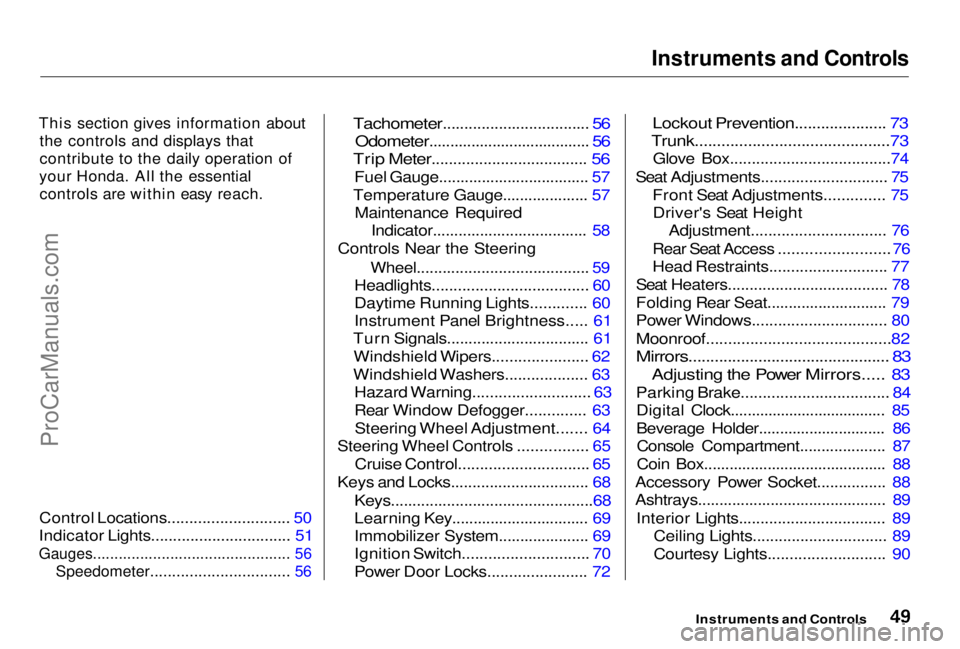
Instruments and Controls
This section gives information about the controls and displays that
contribute to the daily operation of
your Honda. All the essential controls are within easy reach.
Control Locations............................ 50
Indicator Lights................................ 51
Gauges.............................................. 56
Speedometer................................ 56
Tachometer.................................. 56
Odometer...................................... 56
Trip Meter.................................... 56
Fuel Gauge................................... 57
Temperature Gauge.................... 57 Maintenance Required Indicator.................................... 58
Controls Near the Steering
Wheel........................................ 59
Headlights.................................... 60
Daytime Running Lights............. 60
Instrument Panel Brightness..... 61
Turn Signals................................. 61
Windshield Wipers...................... 62
Windshield Washers................... 63
Hazard Warning........................... 63
Rear Window Defogger.............. 63
Steering Wheel Adjustment....... 64
Steering Wheel Controls ................ 65
Cruise Control.............................. 65
Keys and Locks................................ 68
Keys...............................................68
Learning Key................................ 69
Immobilizer System..................... 69
Ignition Switch............................. 70
Power Door Locks....................... 72
Lockout Prevention..................... 73
Trunk............................................73
Glove Box.....................................74
Seat Adjustments............................. 75 Front Seat Adjustments.............. 75Driver's Seat Height Adjustment............................... 76
Rear Seat Access .........................
76
Head Restraints...........................
77
Seat Heaters..................................... 78
Folding Rear Seat............................ 79
Power Windows............................... 80
Moonroof..........................................82
Mirrors.............................................. 83
Adjusting the Power Mirrors.....
83
Parking Brake..................................
84
Digital Clock..................................... 85
Beverage Holder.............................. 86 Console Compartment.................... 87
Coin Box........................................... 88
Accessory Power Socket................ 88
Ashtrays............................................ 89
Interior Lights.................................. 89 Ceiling Lights............................... 89
Courtesy Lights........................... 90
Instruments and ControlsProCarManuals.comMain Menu s t
Page 54 of 278
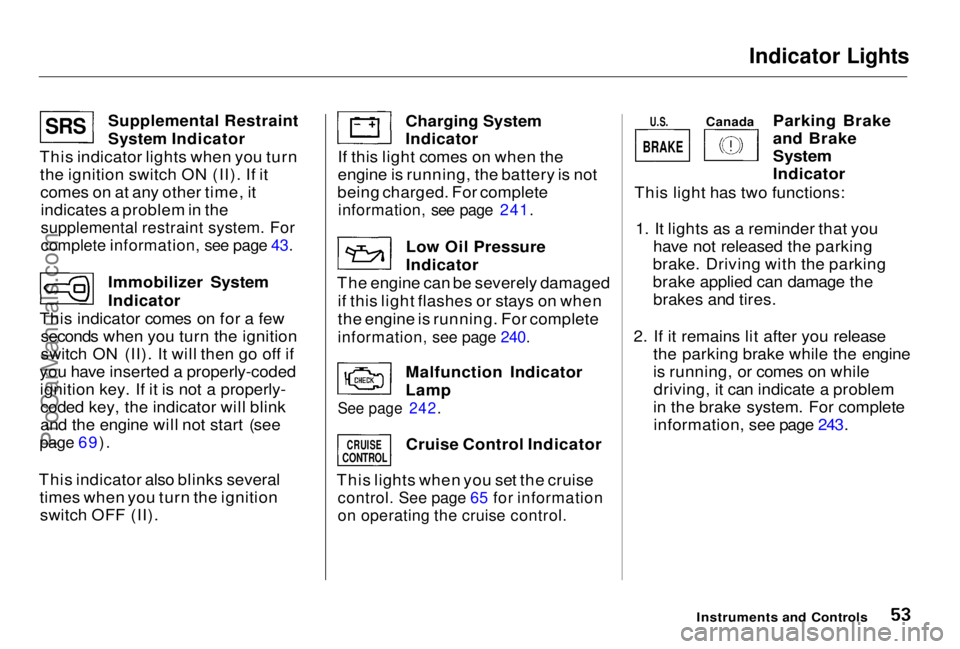
Indicator Lights
Supplemental Restraint
System Indicator
This indicator lights when you turn the ignition switch ON (II). If itcomes on at any other time, itindicates a problem in the
supplemental restraint system. For
complete information, see page 43.
Immobilizer System
Indicator
This indicator comes on for a few seconds when you turn the ignition
switch ON (II). It will then go off if
you have inserted a properly-coded ignition key. If it is not a properly-coded key, the indicator will blink
and the engine will not start (see
page 69).
This indicator also blinks several times when you turn the ignitionswitch OFF (II). Charging System
Indicator
If this light comes on when the
engine is running, the battery is not
being charged. For complete
information, see page 241.
Low Oil Pressure
Indicator
The engine can be severely damaged if this light flashes or stays on when
the engine is running. For complete
information, see page 240.
Malfunction Indicator
Lamp
See page 242.
Cruise Control Indicator
This lights when you set the cruise
control. See page 65 for information
on operating the cruise control.
Parking Brake
and Brake
System
Indicator
This light has two functions:
1. It lights as a reminder that you have not released the parking
brake. Driving with the parking
brake applied can damage the brakes and tires.
2. If it remains lit after you release the parking brake while the engine
is running, or comes on whiledriving, it can indicate a problem
in the brake system. For complete information, see page 243.
Instruments and Controls
S R S
BRAKE
CRUISE
CONTROL
U.S.
Canada
ProCarManuals.comMain Menu Table of Contents s t
Page 59 of 278
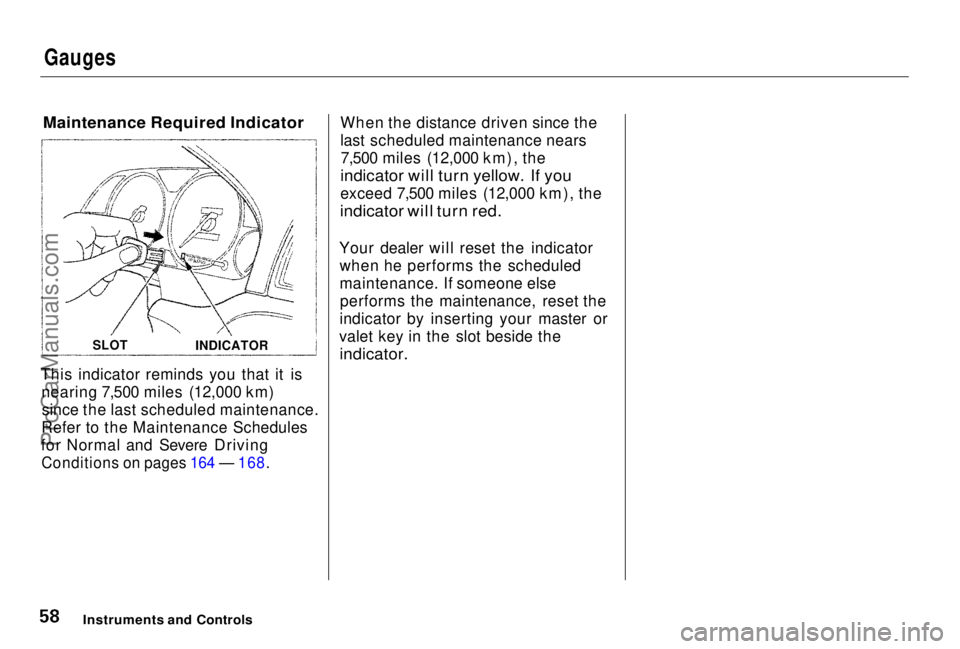
Gauges
Maintenance Required Indicator
This indicator reminds you that it is nearing 7,500 miles (12,000 km)since the last scheduled maintenance.
Refer to the Maintenance Schedules
for Normal and Severe Driving
Conditions on pages 164 — 168.
When the distance driven since the
last scheduled maintenance nears
7,500 miles (12,000 km), the
indicator will turn yellow. If you
exceed 7,500 miles (12,000 km), the
indicator will turn red.
Your dealer will reset the indicator when he performs the scheduled
maintenance. If someone elseperforms the maintenance, reset the
indicator by inserting your master or
valet key in the slot beside the
indicator.
Instruments and Controls
SLOT
INDICATORProCarManuals.comMain Menu Table of Contents s t
Page 69 of 278
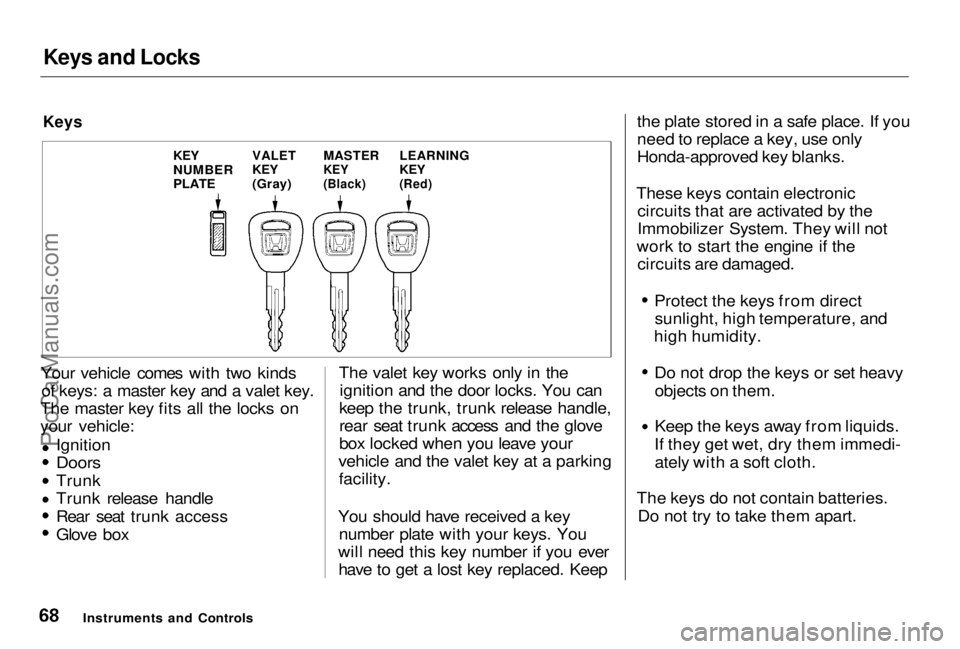
Keys and Locks
Keys
Your vehicle comes with two kinds of keys: a master key and a valet key.
The master key fits all the locks on
your vehicle:
Ignition
Doors
Trunk Trunk release handle
Rear seat trunk access
Glove box The valet key works only in the
ignition and the door locks. You can
keep the trunk, trunk release handle,
rear seat trunk access and the glove
box locked when you leave your
vehicle and the valet key at a parking facility.
You should have received a key number plate with your keys. You
will need this key number if you ever have to get a lost key replaced. Keep the plate stored in a safe place. If you
need to replace a key, use only
Honda-approved key blanks.
These keys contain electronic circuits that are activated by the
Immobilizer System. They will not
work to start the engine if the circuits are damaged. Protect the keys from direct
sunlight, high temperature, and
high humidity. Do not drop the keys or set heavy
objects on them. Keep the keys away from liquids.
If they get wet, dry them immedi- ately with a soft cloth.
The keys do not contain batteries. Do not try to take them apart.
Instruments and Controls
LEARNING
KEY
(Red)
MASTER
KEY
(Black)
VALET
KEY
(Gray)
KEY
NUMBER
PLATEProCarManuals.comMain Menu Table of Contents s t
Page 70 of 278
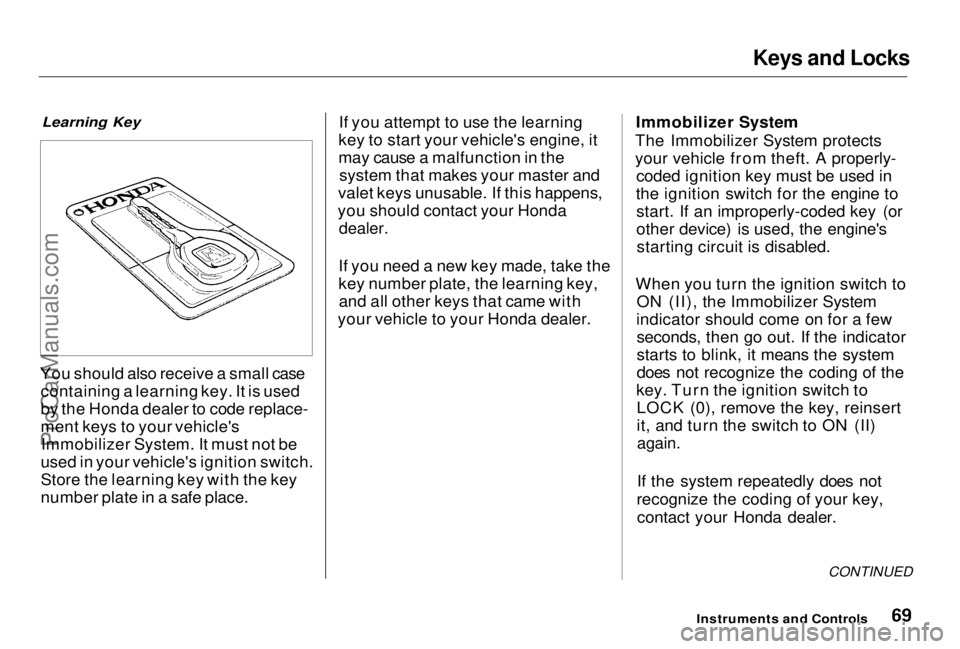
Keys and Locks
Learning Key
You should also receive a small case containing a learning key. It is used
by the Honda dealer to code replace-
ment keys to your vehicle'sImmobilizer System. It must not be
used in your vehicle's ignition switch.
Store the learning key with the key
number plate in a safe place. If you attempt to use the learning
key to start your vehicle's engine, it
may cause a malfunction in the system that makes your master and
valet keys unusable. If this happens,
you should contact your Honda
dealer.
If you need a new key made, take the
key number plate, the learning key, and all other keys that came with
your vehicle to your Honda dealer. Immobilizer System
The Immobilizer System protects
your vehicle from theft. A properly- coded ignition key must be used in
the ignition switch for the engine to start. If an improperly-coded key (or
other device) is used, the engine'sstarting circuit is disabled.
When you turn the ignition switch to ON (II), the Immobilizer System
indicator should come on for a few seconds, then go out. If the indicator
starts to blink, it means the system
does not recognize the coding of the
key. Turn the ignition switch to LOCK (0), remove the key, reinsert
it, and turn the switch to ON (II)
again.
If the system repeatedly does not
recognize the coding of your key, contact your Honda dealer.
CONTINUED
Instruments and ControlsProCarManuals.comMain Menu Table of Contents s t
Page 71 of 278
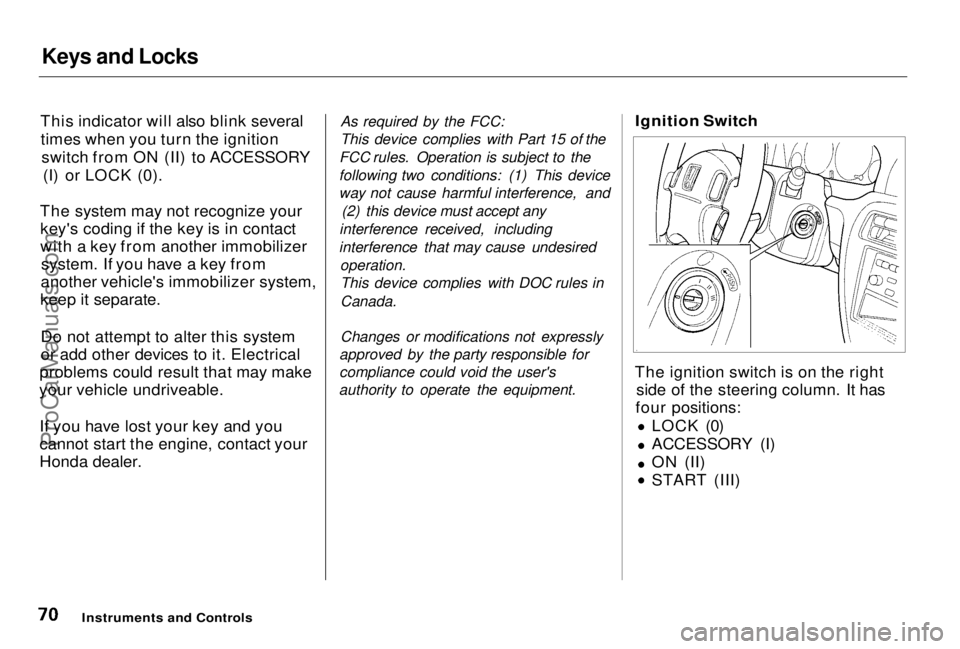
Keys and Locks
This indicator will also blink several times when you turn the ignition switch from ON (II) to ACCESSORY (I) or LOCK (0).
The system may not recognize your key's coding if the key is in contact
with a key from another immobilizer system. If you have a key from
another vehicle's immobilizer system,
keep it separate.
Do not attempt to alter this system
or add other devices to it. Electrical
problems could result that may make
your vehicle undriveable.
If you have lost your key and you
cannot start the engine, contact your
Honda dealer.
As required by the FCC:
This device complies with Part 15 of the
FCC rules. Operation is subject to the
following two conditions: (1) This device
way not cause harmful interference, and (2) this device must accept any
interference received, including
interference that may cause undesired operation.This device complies with DOC rules in
Canada.
Changes or modifications not expressly
approved by the party responsible for
compliance could void the user's
authority to operate the equipment.
Ignition Switch
The ignition switch is on the right side of the steering column. It has
four positions:
LOCK (0)
ACCESSORY (I)
ON (II) START (III)
Instruments and ControlsProCarManuals.comMain Menu Table of Contents s t
Page 72 of 278
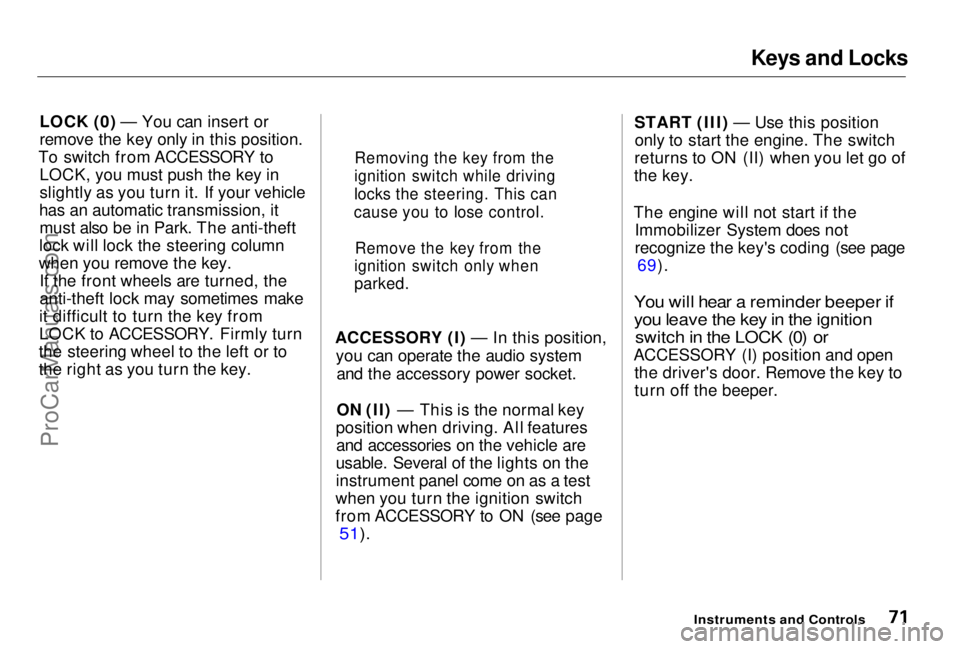
Keys and Locks
LOCK (0) — You can insert or
remove the key only in this position.
To switch from ACCESSORY to LOCK, you must push the key in
slightly as you turn it. If your vehicle
has an automatic transmission, it must also be in Park. The anti-theft
lock will lock the steering column
when you remove the key. If the front wheels are turned, the
anti-theft lock may sometimes make
it difficult to turn the key from
LOCK to ACCESSORY. Firmly turn
the steering wheel to the left or to
the right as you turn the key. ACCESSORY (I) — In this position,
you can operate the audio systemand the accessory power socket.
ON (II) — This is the normal key
position when driving. All features and accessories on the vehicle are
usable. Several of the lights on the
instrument panel come on as a test
when you turn the ignition switch
from ACCESSORY to ON (see page
51).
START (III) — Use this position
only to start the engine. The switch
returns to ON (II) when you let go of
the key.
The engine will not start if the Immobilizer System does not
recognize the key's coding (see page 69).
You will hear a reminder beeper if
you leave the key in the ignition switch in the LOCK (0) or
ACCESSORY (I) position and open the driver's door. Remove the key to
turn off the beeper.
Instruments and Controls
Removing the key from the
ignition switch while driving
locks the steering. This can
cause you to lose control.
Remove the key from the
ignition switch only when
parked.ProCarManuals.comMain Menu Table of Contents s t
Page 73 of 278
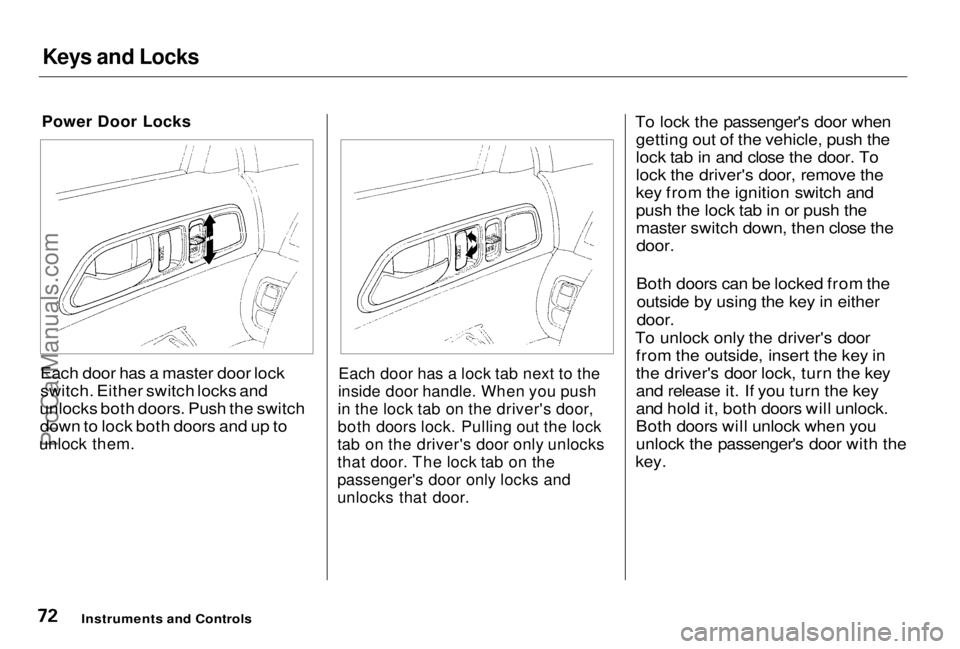
Keys and Locks
Power Door Locks
Each door has a master door lock
switch. Either switch locks and
unlocks both doors. Push the switch down to lock both doors and up to
unlock them.
Each door has a lock tab next to the
inside door handle. When you push
in the lock tab on the driver's door,
both doors lock. Pulling out the lock
tab on the driver's door only unlocks
that door. The lock tab on the
passenger's door only locks and
unlocks that door.
To lock the passenger's door when
getting out of the vehicle, push the
lock tab in and close the door. To
lock the driver's door, remove the
key from the ignition switch and
push the lock tab in or push the
master switch down, then close the
door.
Both doors can be locked from the
outside by using the key in either
door.
To unlock only the driver's door from the outside, insert the key in
the driver's door lock, turn the key
and release it. If you turn the key
and hold it, both doors will unlock.
Both doors will unlock when you
unlock the passenger's door with the
key.
Instruments and ControlsProCarManuals.comMain Menu Table of Contents s t
Page 74 of 278

Keys and Locks
Lockout Prevention
If you forget and leave the key in the
ignition switch, Lockout Prevention
will not allow you to lock the driver's door. With the driver's door open
and the key in the ignition, both
master door lock switches are
disabled.
However, if the driver's door is not open, the master door lock switches
are not disabled. Pushing the switch
down on the open passenger's door
will lock both doors. If you try to lock an open driver'sdoor by pushing in the lock tab, the
tabs on both doors pop out. Pushing
in the lock tab on the passenger's door only locks that door.
Trunk
You can open the trunk in two ways:
Pull the trunk release handle to
the left of the driver's seat. Use the master key to open the
trunk lock. The valet key does not
work in this lock.
To close the trunk, press down on
the trunk lid.
See page 129 for cargo loading and
weight limit information. Keep the
trunk lid closed at all times while
driving to avoid damaging the lid,
and to prevent exhaust gas from
getting into the interior. See Carbon
Monoxide Hazard on page 47.
Instruments and Controls
CONTINUED
TRUNK RELEASE
HANDLE MASTER KEYProCarManuals.comMain Menu Table of Contents s t